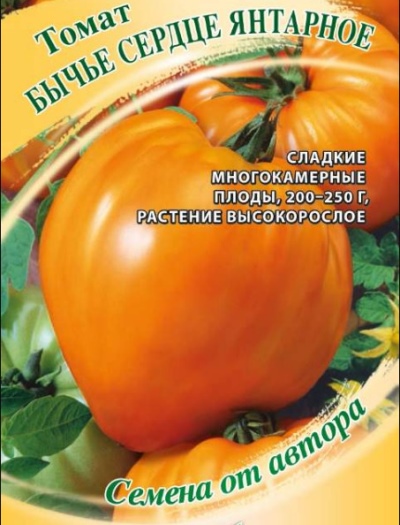
- Authors: Gavrish S.F., Degovtsova T.V., Redichkina T.A.
- Year of approval: 2018
- Category: grade
- Growth type: indeterminate
- Appointment: fresh consumption
- Ripening period: mid-season
- Growing conditions: for film greenhouses
- Bush size: tall
- Bush height, cm: more than 200
- Bush characteristic: powerful
Yellow-fruited, orange tomatoes are becoming more and more popular due to their advantages, the main one of which is hypoallergenic. Yellow tomatoes can be eaten by people with allergies to red vegetables and fruits, as well as young children. The indeterminate variety Bull heart amber belongs to the same group. Its berry is saturated with a large amount of nutrients, it is used for fresh consumption, for slicing and summer salads, many use the surplus for preservation, for example, sauces, winter salads. The variety is grown in all types of greenhouses; in the south of Russia it is possible to grow it outdoors.
Breeding history
The originators of the variety are the breeders of the Gavrish LLC company Gavrish S.F., Degovtsova T.V., Redichkina T.A. The tomato was approved for use in 2018.
Description of the variety
Tall (up to 2 m) indeterminate vigorous bushes are covered with elongated gray-green foliage of the traditional tomato type with characteristic pubescence, aroma and dissection along the edges. Yellow flowers are collected in simple inflorescences, the ovary is attached to a strong articulated peduncle. The brush usually has 6 berries. A powerful, spreading plant is prone to building up a large number of shoots and needs to be formed, pinned, tied up. The stems are quite strong, slightly pubescent. The first fruit cluster is laid after 8 or 9 leaves, all subsequent ones after 1–2 cuttings. The usual number of brushes is 5 to 7.
Features of tomato:
mid-ripeness;
unpretentiousness;
strong immunity;
excellent taste and rich vitamin and mineral composition.
Conditional disadvantages - mandatory observation of the habit (shape, number of shoots, foliage) and its formation.
The main qualities of the fruit
Large (350-400 g) heart-shaped, slightly ribbed fruits are green with a dark spot at the stalk at the stage of immaturity. The berry changes color to amber-orange, reaching the degree of technical and physiological maturity. The peculiarity of the variety is that the first brush pulls out the fruits with the largest weight - the higher the brush, the less weight. Records up to 1 kilogram are known.
The berry is rich in anthocyanins (antioxidants), vitamins, minerals:
proteins fats carbohydrates;
beta-carotene 3.5 mg per 100 g;
vitamins C, B1, B2, B3 (PP), B5, B6 and B9;
calcium, iron, sodium, phosphorus, zinc, selenium and more.
Amber bovine heart refers to low-calorie foods.
Taste characteristics
Medium-dense, sweet fleshy pulp has a high, unique combination of sugars and amino acids. The fruits have almost no voids; the section shows 4 seed chambers with a limited number of seeds.
Ripening and fruiting
The variety belongs to the category of mid-ripening tomatoes - the harvest is harvested in July-August
Yield
Tomato is famous for its high yield - 10.0-12.0 kilograms of tasty and healthy fruits are harvested from 1 square meter.
The timing of planting seedlings and planting in the ground
Sowing seeds for seedlings is carried out at the end of February, at the beginning of March, planting in a permanent place at the end of April, at the beginning of May

Growing tomato seedlings is an extremely important process, because it largely depends on whether the gardener will be able to harvest at all.All aspects must be taken into account, from seedbed preparation to planting in the ground.
Landing scheme
Optimal placement of plants - 40 x 60 cm

Growing and care
Amber bovine heart is grown in seedlings. The tomato loves fertile, breathable soil, good illumination, protection from cold and wind. The indeterminacy of the variety obliges the gardener to take care of the presence of a support or trellis, the bush needs to be formed into 1 stem and pinned. The rest of the care is classic - watering, weeding, loosening and mulching, hilling, timely introduction of nutrients. The first feeding is carried out 10 days after planting in the greenhouse, at which time the tomato is actively increasing its vegetative mass and needs nitrogen. The second time, potassium-phosphorus preparations are introduced during the budding period. Throughout the season, tomatoes can be fed with organic matter - nettle infusions with the addition of bread leftovers, a solution of fresh mullein with the obligatory subsequent dilution of 1: 10. After the formation of a brush, the foliage under it should be removed - this will save the plant from unnecessary waste of nutrients, and will also provide the necessary ventilation ...




A plant needs different micronutrients at each stage of growth. All fertilizers can be divided into two groups: mineral and organic. Folk remedies are often used: iodine, yeast, bird droppings, eggshells.
It is important to observe the rate and period of feeding. This also applies to folk remedies and organic fertilizers.
Disease and pest resistance
Despite the good resistance of the variety to traditional diseases of nightshade crops, it is necessary to carry out preventive treatments with insecticides and fungicides.Such measures will save the plant from pests and diseases.


Resistant to adverse weather conditions
Bovine heart pink is intended for cultivation in film, glass and polycarbonate greenhouses, which means that outdoors it will not be able to withstand frost and sudden temperature changes.
Growing regions
The variety is adapted for greenhouse cultivation throughout Russia - North, North-West, Central, Volgo-Vyatka, TsChO, North Caucasian, Middle Volga, Nizhnevolzhsky, Ural, West Siberian, East Siberian, Far Eastern regions.

























































































